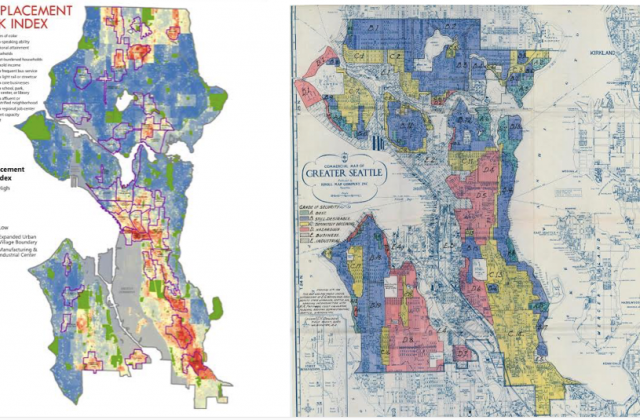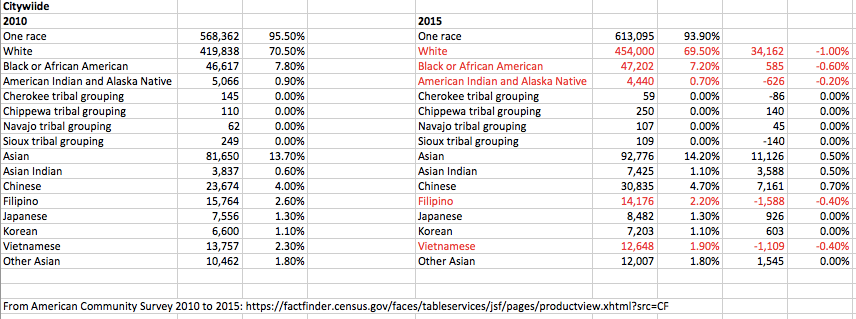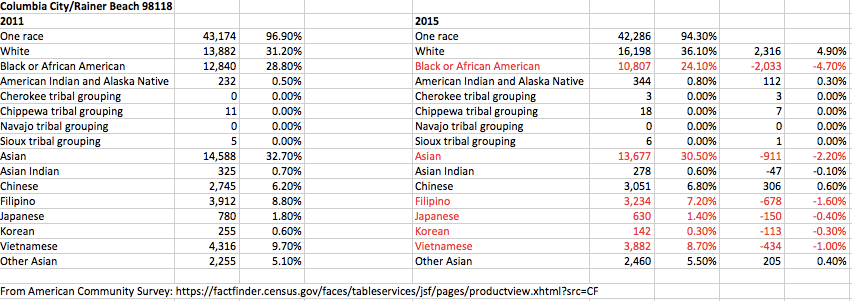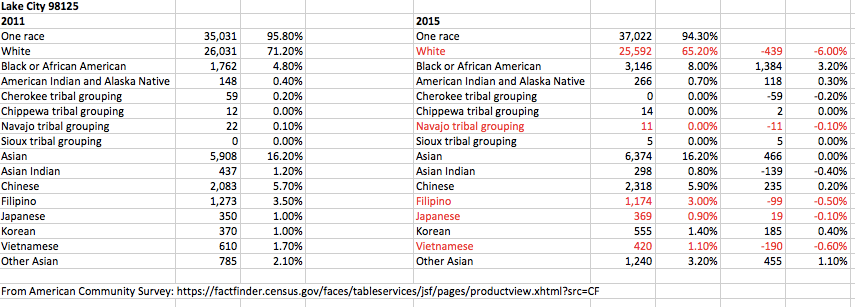Fighting Racism in Seattle Means Building More Housing, Not Less
[They’ll] make you think that they’re doing you a favor. Some of you asked me today about the Oakie Doak, well that is a classic example of the Oakie Doak. And what is the Oakie Doak? A thing, a promise given as if it has great value when in fact it is useless, always designed to deceive, given mostly, but not always, by posturing, pontificating, and picture taking politicians.
Thomas N. Todd
Civil Rights Attorney
Addressing the Ohio Education Association in 2008 on the hazards of non-educational “experts” being recruited to teach in public schools
The other day an article from the Seattle Emerald appeared in my Facebook feed, South End Residents of Color Clap Back at the Times. I resonated with the opening paragraph of the post.
Welcome to Seattle where the rich get richer, Blacks get pushed out, and the Seattle Times prints lazy, racist articles about the South End where many of the city’s remaining People of Color live.
I’ve resisted using the word “lazy” to describe the manifest failure of the Seattle Times to do its job as a daily paper when it comes to covering growth and change in Seattle. How about desultory? The Times just doesn’t know how to see growth except in the most cartoonish terms, and I agree with this writer that the changes in the city’s demographics can’t be summed up the way the Times often does, as an opportunity to panic and fret about changes associated with growth.
But the author commits the same mistake while criticizing the Times when she says that, “Blacks get pushed out.” But she’s not alone in making this statement and when it comes to growth and change the notion that Seattle is in the process of ethnic cleansing is almost never challenged. That’s because, let’s face it, Seattle is a predominantly white city, and most of the people involved in discussions about growth are, in fact, white. When challenged they simply can’t respond for fear of being called racist.
I don’t have that problem. As a person of color, I have long been appalled at the way race is used to promote counterproductive policies in the city when it comes to housing. We have zero quantitative definitions of gentrification and displacement but our answer, as a city, to these poorly defined notions is to limit housing production, tax it, and impose a new form of redlining in areas that the City designates as, “low opportunity.” And, not incidentally, most of the people upset and gesticulating wildly about displacement and gentrification are, you guessed it, white single-family homeowners. Let’s look at three charts of census data.
First of all, as a city, we are becoming less white. The overall percentage of white people dropped by 1 percent, and that means that we have slightly more people of color in the city than we did five years ago. Yes, Black people are fewer as a percentage of overall population, but their overall number is about the same. It’s tough to argue that Black people or people of color are fleeing the city based on these numbers. In fact, the city is sort of staying more or less the same with some tilt away from whiteness.
But what about Seattle’s south end, specifically neighborhoods like Columbia City and Rainier Beach? Well that second chart is for zip code 98118 and includes both of those neighborhoods. Yes, it’s true that the actual number and percentage of Black people in those census tracts has fallen by about 2,000 people or 4.7 percent, and there have been, over about the same period (2011 – 2015) about 2,300 white people.
But before I say anything about that, look at what’s happening in the north Seattle neighborhood of Lake City, zip code 98125. You’ll see that the real number of Black people has increased significantly, by 1,384 while over the same period there are 439 fewer white people. By percentage, the drop in white people in Lake City, 6 percent, is greater than that of the drop of Black people in south Seattle.
So what’s going on?
We simply don’t know.
One damaging and sort of hopeless narrative is articulated in the first paragraph of the post I started out with: Black people, 2,000 of them, have been forced out by 2,300 white people. This story is all about opportunistic white people willfully squeezing out poorer but established Black families, opening up fancy coffee shops and restaurants, and wiping out the culture of the neighborhood to make it more white. Where are those Black people going? They are moving out of Seattle, and the city is becoming more and more white.
Who benefits from the status quo and not building more housing? Single-family homeowners who will see their investment “skyrocket” in value because demand is increasing and supply for new housing options isn’t keeping up. And guess what, those homeowners are mostly white.
OK.
Or, maybe many of those Black people moved to Lake City. Would anyone argue that those white people in Lake City were, “displaced” by Black people? Is Lake City undergoing a de-gentrification? And where did the 359 Native Americans and Asians go between 2011 and 2015? Were they forced out by the influx of Blacks into the neighborhood?
Why in the world would we conclude these things based on so little data? This hopscotch of conclusion jumping has currency because it serves a larger, anti-housing and counter productive narrative about race and growth. The story is about ethnic cleansing, victimization, and keeping the status quo. But who benefits from the status quo and not building more housing? Single-family homeowners who will see their investment “skyrocket” in value because demand is increasing and supply for new housing options isn’t keeping up. And guess what, those homeowners are mostly white.
We could probably figure out why people of various income levels, races, and other designations have moved or are moving. We could go door to door, recruit people to participate in a years long study and track their movements, ask lots of questions, and measure dozens of variables like gross income, wages, inflation, regional demographic trends, and a host of others. We could establish control groups. We could spend millions to pinpoint exactly why the south end has lost black people and Lake City has gained black people. Or we could just believe its about ethnic cleansing because that supports what we’ve already concluded: things are bad because people from the outside are pouring in to steal from us and make life worse.
Or we could all work together to build more housing, of all kinds, in all parts of the city, for all levels of income. White people who don’t want change are exploiting people of color in Seattle ruthlessly, using the challenges faced by people with less money and fewer resources as an excuse to preserve their own hegemony and wealth. Data actually support this conclusion : as supply drops, price goes up, people with less money who are disproportionately people of color, can’t compete for existing housing.
Even our suffering and poverty is taken from us to benefit people who already have money, wealth and dominance
There is simply no data, none, zero, nada, that supports a narrative that white people are willfully forcing their way in to any neighborhood and forcing black people out. Ironically, that story and the “solution” for it of building no more housing in the south end or taxing it only makes prices higher and actually accelerates the problem all poorer people face when looking for housing. It’s actually a form of redlining that masquerades as noblesse oblige.
People of color in Seattle, when it comes to housing in particular, are not being served by arguing for interventions that make it harder to build more housing. We are not helped demographically or economically or culturally by banding together with know nothing neighbors who say that new housing is racist. We, in truth, being once again exploited and taken advantage of to benefit the dominant culture; even our suffering and poverty is taken from us to benefit people who already have money, wealth and dominance.
This is already a long post, but I am going to quote from a Ta-Nehisi Coates who quotes this passage, a lament by Private Thomas Strother of the United States Colored Troops, (I first heard the quote watching Death and the Civil War):
To suppose that slavery, the accursed thing, could be abolished peacefully and laid aside innocently, after having plundered cradles, separated husbands and wives, parents and children; and after having starved to death, worked to death, whipped to death, run to death, burned to death, lied to death, kicked and cuffed to death, and grieved to death; and, worst of all, after having made prostitutes of a majority of the best women of a whole nation of people . . .would be the greatest ignorance under the sun.
Last week a black woman in our city called the police for help because she thought someone was trying to break into her apartment. She likely was afraid and troubled enough she grabbed a knife, and was holding it when she answered the door (many of the facts about this and what they mean are still in dispute). Seattle police shot and killed her in front of her children. Would they have done the same to me? Probably not. I’m not black.
We’re not going to get over or solve the scourge of slavery in my lifetime. In fact, there are people, many people, alive today that lived in an America in which to marry, or use the same water fountain, stay in the same hotel, or live in the same neighborhood as a white person was illegal and could result in death. Do you think we’re over that yet? We’re not. Racism is real and alive and well right around the corner. Your corner. And you might even be racist yourself.
But the notion that the development and construction of new housing in our city is racist or contributes to displacement or harms people of color or people with less money to spend is the opposite of what we know about economics. We’re being played, and played hard. The best thing for people of color and poor people to do is demand more and more housing and to seek out every opportunity to build housing ourselves, in our own communities and everywhere else. That’s the only way we’re going to make this city a safe and prosperous place for everyone who wants to live here.





